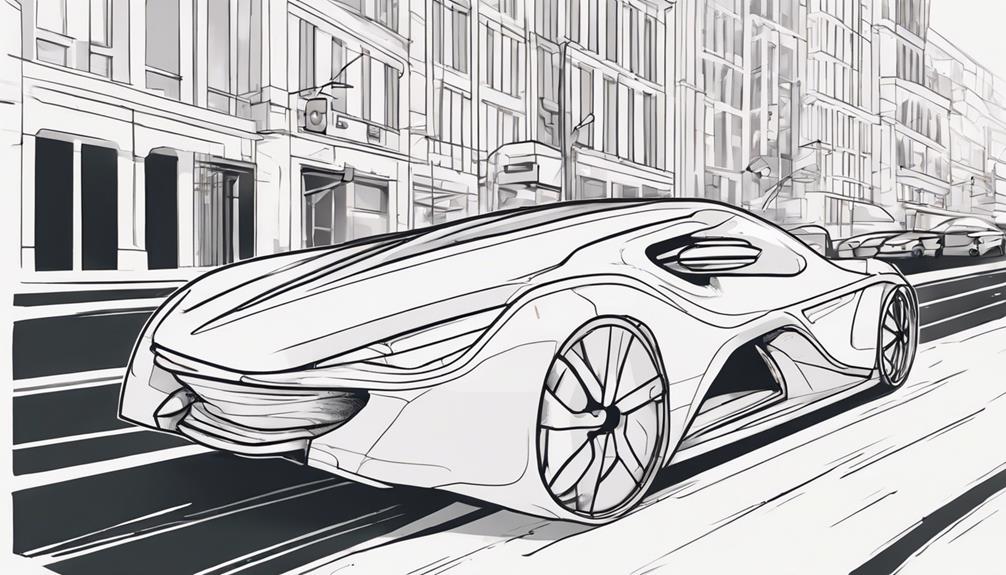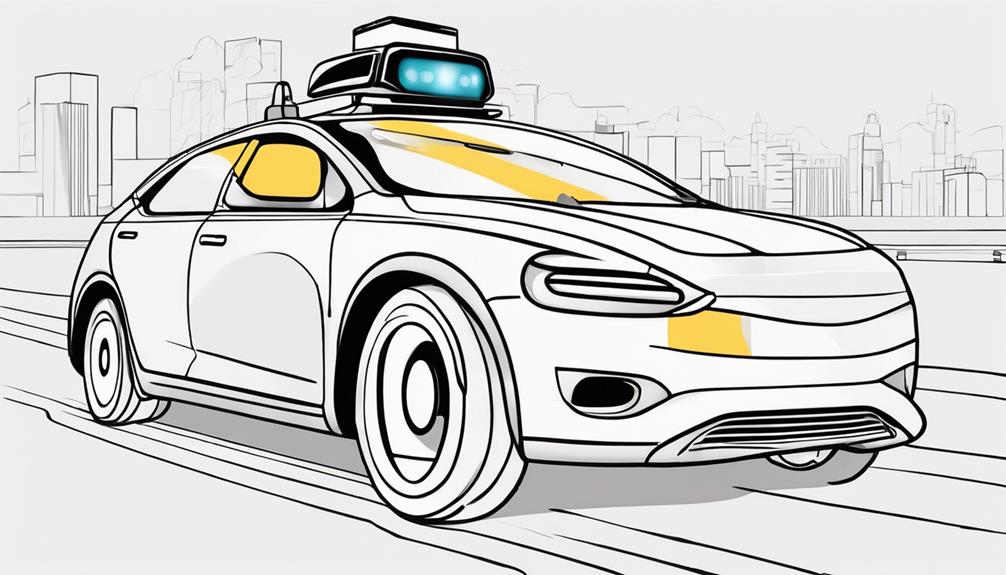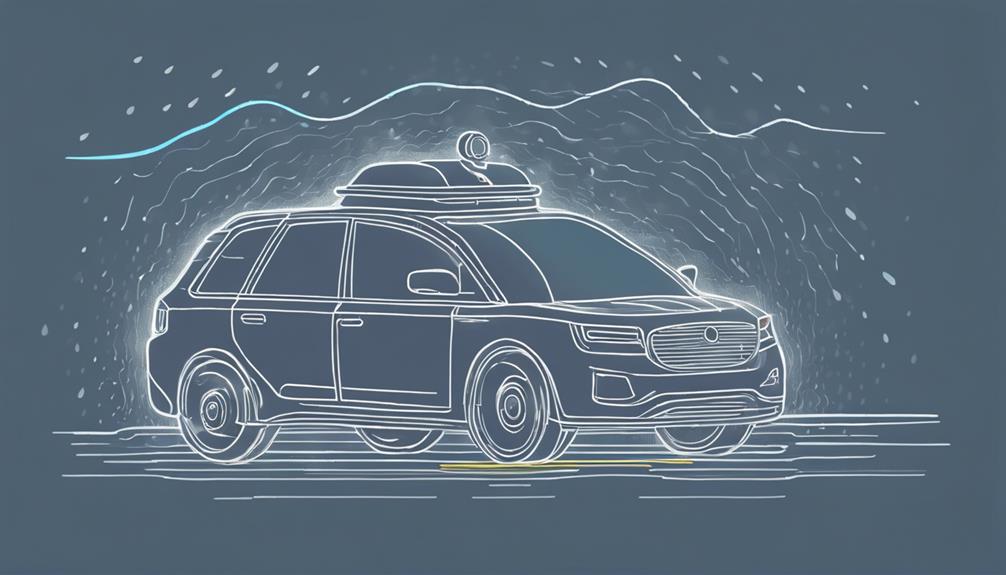Self-driving cars, also known as autonomous vehicles, represent a significant advancement in the automotive industry. These vehicles utilize a combination of cutting-edge technologies to navigate roads and transport passengers without human intervention. The intricate fusion of sensors, cameras, and artificial intelligence systems enables self-driving cars to perceive their surroundings and make real-time decisions. But how do these systems truly function in unison to ensure safe and efficient travel? Let's explore the underlying mechanisms and complexities that drive the evolution of autonomous driving technology.
Key Takeaways
- Self-driving cars operate autonomously using sensors, cameras, radar, and AI technology.
- Autonomy levels range from 0 (human-controlled) to 5 (fully autonomous) with various safety measures.
- GPS technology enhances route mapping and location accuracy for safe and efficient operation.
- Challenges in self-driving technology include object identification, decision-making, liability, and cybersecurity risks.
Definition of Self-Driving Cars

A self-driving car, also known as an autonomous vehicle, is an automobile capable of navigating and operating without direct human input by utilizing an array of sensors, cameras, radar systems, and artificial intelligence technology. These autonomous vehicles operate based on different levels of automation as defined by the Society of Automotive Engineers (SAE), ranging from Level 0 where the vehicle is human-controlled to Level 5 where it is fully autonomous. Levels 3 and 4 may require occasional human intervention, while Level 5 operates without any human input, even in complex environments.
Artificial intelligence plays a crucial role in the functioning of self-driving cars. Through algorithms, machine learning, and advanced sensors like radar, cameras, and LiDAR, these vehicles are capable of perceiving their environment and making decisions in real-time. The AI technology used in autonomous vehicles processes data from various sensors to detect and respond to traffic, pedestrians, obstacles, and road conditions, enabling the vehicle to navigate safely and efficiently.
How Autonomous Vehicles Operate
Autonomous vehicles operate through a sophisticated system of sensors that capture data about the vehicle's surroundings. This data is then processed by advanced decision-making algorithms, allowing the vehicle to navigate its environment and make real-time decisions. Integration with GPS technology further enhances the vehicle's ability to map routes and reach destinations efficiently.
Sensors in Self-Driving Cars
Utilizing an array of sensors, self-driving cars meticulously scan and interpret their surroundings to navigate autonomously and ensure operational safety. These sensors include radar, lidar, cameras, and ultrasonic sensors, each serving a specific purpose in gathering data essential for the vehicle's decision-making process.
- Radar: Utilized for detecting objects at a distance by sending out radio waves and analyzing the returning signals.
- Lidar: Uses laser light to create high-resolution 3D maps of the surroundings, aiding in precise object detection and localization.
- Sensor Fusion: Integrating data from various sensors to create a comprehensive understanding of the environment, enhancing the car's ability to make informed decisions.
These sensor technologies collectively enable self-driving cars to operate efficiently and safely, paving the way for the advancement of autonomous vehicles.
Decision-Making Algorithms
How do decision-making algorithms enable self-driving cars to navigate complex environments autonomously and respond effectively to dynamic driving scenarios? Self-driving technology relies on sophisticated decision-making algorithms that integrate machine learning and artificial intelligence. These algorithms process data collected from sensors to interpret road conditions, traffic flow, pedestrian behavior, and other critical factors in real-time. By continuously analyzing this information, autonomous vehicles can make informed decisions to navigate challenging situations and adapt to changing environments. The use of decision-making algorithms enhances the driving capabilities of self-driving cars, enabling them to operate safely and efficiently. The success of these algorithms is crucial in ensuring the precision and reliability of autonomous vehicles in various driving scenarios.
Integration With GPS
Integrating GPS technology is fundamental for the operation of autonomous vehicles as it provides precise location data and facilitates navigation to predetermined destinations.
- GPS systems enable autonomous vehicles to determine their exact location and navigate efficiently.
- Real-time maps and traffic information obtained through GPS technology aid in route optimization.
- Autonomous cars leverage GPS data to plan optimal routes, circumvent traffic congestion, and execute informed driving decisions.
The seamless integration with GPS enhances the autonomous capabilities of vehicles, ensuring safe and efficient operation in diverse driving scenarios. GPS plays a pivotal role in providing accurate positioning and location awareness, contributing significantly to the overall functionality of self-driving cars.
Technology Behind Driverless Cars
With the rapid advancement of technology, self-driving cars rely on a sophisticated combination of sensors, cameras, radar, and artificial intelligence to operate autonomously. These components work together to provide advanced safety features and enable the vehicle to navigate roads without human intervention. Major companies such as Google, Tesla, Ford, and Volvo are at the forefront of developing fully automated vehicles that incorporate cutting-edge autonomous technology.
To further illustrate the technology behind driverless cars, the following table highlights key components used in autonomous driving systems:
| Component | Functionality |
|---|---|
| Sensors | Detect obstacles, lane markings, and traffic signs |
| Cameras | Provide visual input for object recognition |
| Radar | Measure distance and speed of surrounding objects |
| Artificial Intelligence | Process data and make driving decisions |
These technologies work in sync to create a comprehensive system that can interpret the environment, make real-time decisions, and ensure safe navigation for self-driving cars.
Understanding Autonomous Driving Systems

Advancements in autonomous driving systems have revolutionized the automotive industry by integrating cutting-edge technology to enable vehicles to operate without human intervention. These systems utilize a combination of sensors, cameras, radar, and artificial intelligence to perceive and interpret the vehicle's surroundings, allowing for autonomous navigation and decision-making. Key points to understand about autonomous driving systems include:
- Levels of Autonomy: Autonomous driving systems are categorized into different levels, ranging from Level 0 where the vehicle is fully human-driven to Level 5 where the vehicle is entirely autonomous, requiring no human intervention.
- Self-Driving Features: Self-driving cars incorporate features such as adaptive cruise control and hands-free steering to enhance safety and convenience for passengers.
- Technology Integration: Companies like Google's Waymo and GM are at the forefront of developing autonomous vehicles, integrating advanced sensor technology and neural networks to enhance the capabilities of self-driving cars.
These advancements in autonomous driving systems are paving the way for a future where vehicles can navigate roads independently, offering increased safety and efficiency on the streets.
Levels of Autonomy in Vehicles
The levels of autonomy in vehicles, as defined by the Society of Automotive Engineers (SAE), provide a structured framework for understanding the progression towards fully autonomous driving. Each level represents a different degree of automation, from basic driver assistance at Level 1 to complete autonomy at Level 5. Understanding these levels is crucial for evaluating the capabilities and safety measures implemented in self-driving technologies.
Autonomy Levels Explained
Defined by the Society of Automotive Engineers (SAE), there are six distinct levels of autonomy in vehicles, delineating the progression from no automation to full automation.
- Level 1 autonomy involves driver assistance systems like adaptive cruise control.
- Level 2 autonomy includes systems like Tesla's Autopilot, where the vehicle can control steering, acceleration, and braking.
- Levels 3 and 4 autonomy introduce higher levels of automation, with Level 4 allowing the vehicle to operate without human intervention in certain conditions.
These levels represent a crucial framework for understanding the capabilities and limitations of autonomous vehicles, providing a roadmap for the advancement of technology towards achieving full automation.
Safety Measures Implemented
In the realm of autonomous vehicles, the implementation of safety measures is paramount, especially as vehicles progress through different levels of autonomy. As cars advance from Level 0 (human-driven) to Level 5 (fully autonomous), the incorporation of safety features becomes increasingly critical. Driver-assistance systems play a vital role in enhancing safety at various levels of automation. For instance, at Level 3, where human intervention may still be necessary, these systems assist drivers in making rapid decisions. In contrast, at Level 4 and Level 5, where vehicles operate autonomously, safety measures such as sensors, cameras, radar, and artificial intelligence (AI) are utilized to ensure swift responses to diverse driving scenarios. Production cars are now integrating autonomous features like hands-free steering and adaptive cruise control to further bolster safety on the roads.
Operational Mechanisms of Self-Driving Cars

Utilizing a sophisticated array of sensors, cameras, radar technology, and artificial intelligence, self-driving cars operate autonomously without human intervention. These vehicles function based on neural networks and deep learning algorithms that enable them to make complex decisions on the road. Levels of autonomy in self-driving cars range from Level 0, where the vehicle requires full human control, to Level 5, where the car is fully autonomous and does not need any human input.
- Neural Networks and Deep Learning: Self-driving cars rely on advanced neural networks and deep learning algorithms to process the vast amount of data collected by their sensors and cameras, allowing them to make real-time decisions and navigate various driving scenarios.
- Lidar, Cameras, and Sensors: Autonomous cars use lidar, cameras, and sensors to identify and predict objects in their surroundings, creating a detailed understanding of the environment to make informed decisions while driving.
- Data Processing and Action Triggering: Sensors in self-driving cars continuously feed data to onboard processors, enabling the vehicles to execute actions such as braking and steering autonomously based on predefined algorithms and machine learning models.
Advantages of Autonomous Vehicles
Autonomous vehicles offer a transformative solution to transportation challenges by significantly reducing traffic accidents and increasing mobility for various demographics. Fully autonomous cars have the potential to revolutionize road safety by eliminating over 90% of accidents caused by human error. This advancement not only enhances safety but also improves efficiency on the roads. By optimizing traffic flow and coordination through vehicle communication, self-driving cars can help alleviate traffic congestion, leading to smoother and more efficient transportation systems. Additionally, self-driving cars provide increased mobility for individuals who may face limitations, such as the elderly and disabled, granting them independence and access to transportation services. As a result, commuters benefit from more free time, as self-driving cars take over driving tasks, enabling passengers to engage in other productive activities. The advantages of autonomous vehicles extend beyond convenience to encompass improved road safety and enhanced overall transportation efficiency.
| Advantages of Autonomous Vehicles | ||
|---|---|---|
| Significantly reduce traffic accidents | Increase mobility for elderly and disabled | Optimize traffic flow and reduce congestion |
| Enhance road safety | Provide more free time for commuters | Promote efficient transportation systems |
Challenges in Self-Driving Technology

The advancement of self-driving technology is met with significant challenges, particularly in the areas of object identification, decision-making capabilities, liability concerns, and cybersecurity risks. Factors like tunnels, construction projects, and GPS disruptions can impact the functionality of self-driving cars. Safety concerns, the need for quick responses in various driving scenarios, and cybersecurity risks are key challenges in autonomous driving. Cybersecurity risks must be mitigated to ensure the safe operation of self-driving vehicles. Legal and safety challenges need to be addressed for the widespread adoption of self-driving cars.
- Level 5 car development requires overcoming complex technological hurdles.
- Automatic emergency braking systems must be reliable and responsive in all situations.
- Advanced driver assistance systems need to seamlessly integrate with self-driving technology for enhanced safety and performance.
Frequently Asked Questions
What Is the Self-Driving Car?
A self-driving car is a vehicle that utilizes advanced technology to navigate autonomously, without human intervention. This technology involves a complex system of sensors, cameras, radar, and artificial intelligence algorithms to perceive and interact with the surrounding environment. As these vehicles continue to evolve, issues such as technological advancements, ethical considerations, and future implications are crucial factors that need to be carefully addressed to ensure safe and efficient integration into society.
What Is an Example of a Self-Driving Vehicle?
An example of a self-driving vehicle is an autonomous taxi. These vehicles, also known as robot shuttles or driverless buses, operate without human intervention. They utilize advanced technologies such as cameras, sensors, and artificial intelligence to navigate roads, pick up passengers, and drop them off at their destinations. Autonomous taxis represent a significant advancement in transportation, offering a glimpse into the future of automated mobility services.
Are Self Driving Cars Good or Bad?
When examining the topic of self-driving cars and their impact, it is crucial to consider the spectrum of pros and cons they present. Ethical dilemmas arise concerning issues such as liability for accidents and the potential displacement of workers in certain industries. While autonomous vehicles offer enhanced safety and efficiency on the roads, questions surrounding privacy, cybersecurity, and the overall societal implications of widespread adoption persist.
Can Any Car Be Self-Driving?
Retrofitting cars for self-driving capabilities involves integrating complex sensor systems and AI technologies. Legal implications arise concerning liability and regulations for autonomous vehicles. Safety concerns must be addressed to ensure reliability and reduce the risk of accidents. Retrofitting any car requires significant investment and expertise to meet the necessary standards for autonomous operation. Considerations of safety, legality, and technical feasibility are crucial in the pursuit of self-driving capabilities for any vehicle.
Conclusion
In conclusion, self-driving cars represent a significant advancement in automotive technology, offering increased safety and convenience for drivers. The intricate network of sensors, cameras, and artificial intelligence enables these vehicles to navigate roads autonomously, reducing the risk of human error. Despite facing challenges such as regulatory hurdles and technological limitations, the potential benefits of self-driving cars in improving road safety and efficiency are undeniable. The future of autonomous vehicles holds promise for revolutionizing the way we travel.
